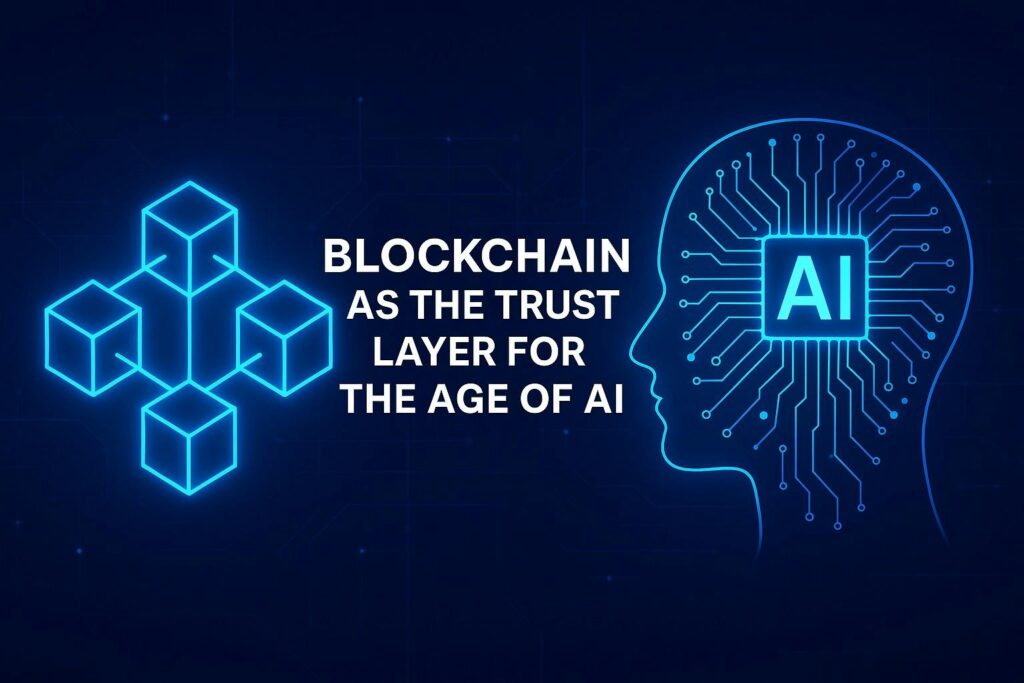As artificial intelligence continues to evolve from narrow applications to autonomous agents, one foundational question becomes increasingly urgent: how can we trust what we can’t fully understand or control?
This is not just a philosophical concern. In real-world systems—from finance to medicine, supply chains to governance—AI is making decisions with real consequences. But without a robust trust layer, these systems become vulnerable to manipulation, error, and opacity.
Blockchain is not just a financial tool or decentralized database — it is a necessary trust infrastructure for the AI-powered world. Here’s why.
1. 🔐 Trust Without Intermediaries
The problem:
When AI agents make decisions in finance, healthcare, logistics, or law, how can we ensure those decisions are authentic, immutable, and verifiable—without blindly trusting a central server?
The blockchain solution:
Blockchain provides a decentralized, tamper-proof ledger. Hashes of AI outputs—diagnoses, transactions, recommendations—can be recorded immutably, proving what was done and when, without revealing sensitive data.
Example:
An AI diagnoses a patient. The hash of the diagnosis is stored on-chain. A regulator or patient can later confirm the diagnosis hasn’t been altered, without accessing the medical content itself.
2. 🧠 Transparency & Accountability
The problem:
AI systems often operate as black boxes. Without visibility into what decisions were made and why, trust collapses—especially when errors or bias arise.
The blockchain solution:
Key AI actions can be hashed and logged in a public or permissioned blockchain, providing an audit trail. This balances transparency with privacy and creates a layer of accountability.
Example:
An AI agent approves a loan. Its decision process is hashed and stored on-chain. This allows later audits—even by external parties—without exposing client data.
3. 🛡 Data Integrity & Privacy
The problem:
AI systems process vast volumes of sensitive data. Storing or transmitting this data without guarantees of integrity exposes the entire system to risks.
The blockchain solution:
Data remains in secure storage, but cryptographic hashes are stored on-chain. This enables proof-of-integrity without revealing the data itself.
Example:
Medical records remain in a secure database. Their hash is logged on-chain. Any tampering with the original record can be instantly detected via hash mismatch.
4. 🤖 Automation with Smart Contracts
The problem:
When AI agents interact with each other and humans, how do we enforce agreements or actions in a trustless environment?
The blockchain solution:
Smart contracts can automatically execute transactions—payments, rights transfers—once conditions are met. These conditions can include AI-generated inputs validated on-chain.
Example:
An AI agent confirms a delivery via GPS and timestamp. The event hash is recorded on-chain, triggering a smart contract that automatically pays the driver.
5. 🧬 Manipulation Resistance
The problem:
In the AI era, it’s easier than ever to fabricate data, decisions, or interactions. Even AI itself can be manipulated or corrupted by bad actors.
The blockchain solution:
Blockchain’s immutability means any post-facto alteration is easily detectable. This creates a verifiable history immune to tampering.
Example:
An AI system logs a product quality check in a supply chain. If someone later attempts to falsify the report, the blockchain hash will reveal the discrepancy.
6. 🫂 Building Humane Infrastructure
The problem:
As AI systems become part of critical social infrastructure, we must ensure they operate ethically, transparently, and under human oversight.
The blockchain solution:
Blockchain enables verifiable governance of AI actions. It can support human oversight panels, citizen verifiability, and digital rights enforcement via technical means—not just legal ones.
Example:
In a blockchain-based voting system managed by AI agents, vote hashes are recorded immutably, ensuring transparency and eliminating the possibility of vote tampering.
7. 🌍 Global Scalability & Coordination
The problem:
AI agents interact across borders, cultures, jurisdictions—and require a shared foundation of trust.
The blockchain solution:
Blockchains are borderless, decentralized, and accessible to all network participants. They serve as a universal source of verifiable truth across fragmented systems.
Example:
In a global logistics network, AI agents record shipment events on a shared blockchain. All stakeholders—from factories to regulators to customers—can verify events without trusting a single central entity.
Why This Is Critical
- The Rise of Autonomous Agents:
- We are entering an era where AI systems will act independently. Without a verifiable trust layer, accountability becomes nearly impossible.
- Symbiosis Between Humans & AI:
- Blockchain builds a trust bridge between human society and autonomous systems—enabling oversight, control, and peace of mind.
- The Trust Economy:
- In a world where data and decisions are the new currency, blockchain protects this currency from forgery and abuse.
- Ethical and Safe AI:
- To ensure AI serves humanity—rather than undermines it—we must embed transparent, verifiable accountability into its very architecture.
Final Thought
Blockchain is not a buzzword or side technology — it’s the backbone for a verifiable, ethical, and human-centered AI future.
It replaces slow, fallible human guarantees with cryptographic certainty. Without it, the AI revolution risks becoming ungovernable.

